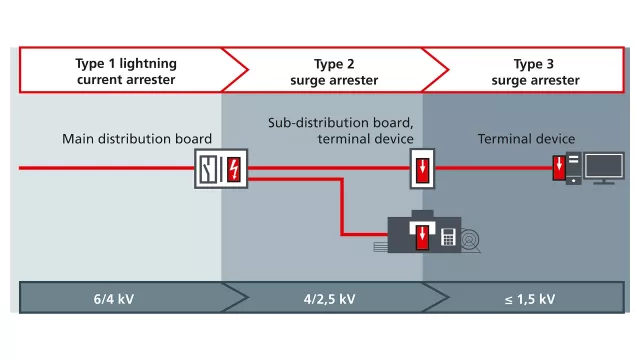Surge protection for hospitals
The electrical and electronic systems in hospitals are vital for patients and must function reliably as part of increasing digitalisation processes. Good reasons to protect sensitive systems from direct and indirect lightning strikes.
Our standard-compliant surge protection solutions, developed from decades of expertise, ensure that dangerous interference energy is reliably reduced to a harmless level and that operations in the hospital run smoothly.

Well-planned surge protection with lightning equipotential bonding
The consequences of a lightning strike are particularly serious in hospitals. After all, it's not just about the destruction of valuable technology, but above all about human lives. Comprehensive lightning equipotential bonding for all electrical cables routed into the building from outside is an important basis for protecting the functioning of sensitive systems in the hospital. The standards IEC 62305-3 and 62305-4 apply as a basic requirement for the protection of sensitive components when planning and implementing surge protection with lightning equipotential bonding.
How our surge protection concepts work
Surge protection devices are divided into lightning current arresters, surge arresters and combined arresters. Which arrester types are used where is determined in the lightning protection zone concept.
Lightning current arresters and combined lightning current arresters establishing the transition from lightning protection zone 0A to 1 or 0A to 2 are subject to the highest requirements with regard to discharge capacity. These arresters must be capable of carrying partial lightning currents of the 10/350 μs waveform in a non-destructive manner in order to prevent destructive partial lightning currents from entering the electrical system of a building.
At the transition from lightning protection zone 0B to 1 (or downstream of the lightning current arrester at the transition from lightning protection zones 1 to 2 and higher), surge arresters are used to protect against overvoltages. Their task is to further attenuate the residual energy of the upstream protection stages as well as to limit the overvoltages induced in the system or generated there itself.
Learn more about our surge protection concepts for hospitals. We are eager to cater to your specific requirements.
Relevant standards for the surge protection of hospitals
IEC 62305-3 and 62305-4 regulate the planning and implementation of surge protection with equipotential bonding for hospitals.
Downloads
DEHN protects technical building equipment
Fire alarm systems
Main low-voltage distribution boards from G. Klampfer Elektroanlagen GmbH
Services
We can provide support for your project from the planning to the implementation and beyond. Take advantage of our wide range of practical tools and services.
